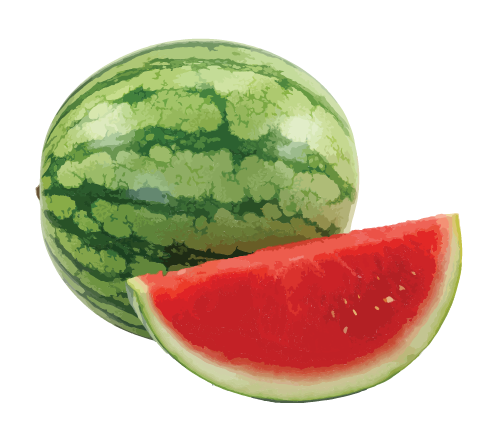Eat Smart, Move More at Farmers Markets: Watermelon
ID
HNFE-320-15NP

Key Points
- High in vitamins A and C and high in lycopene. Contains carotenoids that may be good for health.
- Choose symmetrical watermelons with dried stems and yellowish undersides that are heavy for their size.
- Wash hands with warm water and soap for at least 20 seconds before and after handling fresh fruits and vegetables.
- Store whole watermelons at room temperature. Refrigerate cut watermelons in airtight container for use within five days.
Watermelon Onion Salad
Number of servings: 4
Ingredients:
6 cups watermelon, cut into 1-inch cubes
2 green onions
1/3 cup red onion
1/3 cup mint leaves
1 tablespoon red pepper flakes
2/3 cup white vinegar
2 tablespoons vegetable oil
1 tablespoon chili powder
Directions:
- Cut watermelon in slices, then into 1-inch cubes. Remove seeds and add to large bowl.
- Cut ends and top off of green onions and chop into small pieces. Add to bowl.
- Cut the ends off of the red onion and peel off the brown layers. Run under water to remove any dirt. Cut the onion in half lengthwise, and place the flat side on the cutting board. Slice across the onion, from one side to the other, then lay the slices on their sides, and slice from the widest side to the smallest, across the onion. Cut into slices and then into pieces to get 1/3 cup. Add to bowl.
- Wash and cut mint leaves into small pieces. Add to bowl.
- In a separate bowl, add red pepper flakes, vinegar, vegetable oil, and chili powder. Stir well.
- Pour over watermelon mixture, mix well, and serve
Per serving: 157 calories; 8 g fat (1 g saturated fat); 2 g protein; 22 g carbohydrate; 3 g dietary fiber; 0 mg cholesterol; 28 mg sodium.
Watermelon Salsa
Number of servings: 4
Ingredients:
3 cups watermelon, cut in bite-size pieces
1 green bell pepper
2 tablespoons lime juice
2 tablespoons fresh cilantro, chopped
1 green onion, chopped
1 jalapeno pepper
1/4 teaspoon garlic powder
Directions:
- In a large bowl, combine the watermelon, green pepper, lime juice, cilantro, green onion, jalapeno, and garlic salt. Mix well and serve.
Per serving: 33 calories; 1 g fat (trace saturated fat); 1 g protein; 8 g carbohydrate; 1 g dietary fiber; 0 mg cholesterol; 3 mg sodium.
Quick Tips
- Puree watermelon and pour into small paper cups and freeze for a healthy snack.
- Clean watermelon and other firm-skinned produce under running tap water while rubbing with your hands or scrubbing with a clean brush.
- Add thin slices of watermelon to your favorite sandwich as a substitute for tomatoes.
- No matter how you slice it, your kids will love watermelon.
This institution is an equal opportunity provider. In accordance with Federal law and U.S. Department of Agriculture (USDA) civil rights regulations and policies, this institution is prohibited from discriminating on the basis of race, color, national origin, sex, age, disability, and reprisal or retaliation for prior civil rights activity. (Not all prohibited bases apply to all programs.) This material was partially funded by USDA’s Supplemental Nutrition Assistance Program – SNAP – and the Expanded Food and Nutrition Education Program (EFNEP). SNAP is funded by the U.S. Department of Agriculture Food and Nutrition Service and the Expanded Food and Nutrition Education Program (EFNEP) is funded by the U.S. Department of Agriculture, National Institute of Food and Agriculture (USDA/NIFA).
Virginia Cooperative Extension materials are available for public use, reprint, or citation without further permission, provided the use includes credit to the author and to Virginia Cooperative Extension, Virginia Tech, and Virginia State University.
Virginia Cooperative Extension is a partnership of Virginia Tech, Virginia State University, the U.S. Department of Agriculture (USDA), and local governments, and is an equal opportunity employer. For the full non-discrimination statement, please visit ext.vt.edu/accessibility.
Publication Date
February 8, 2021



